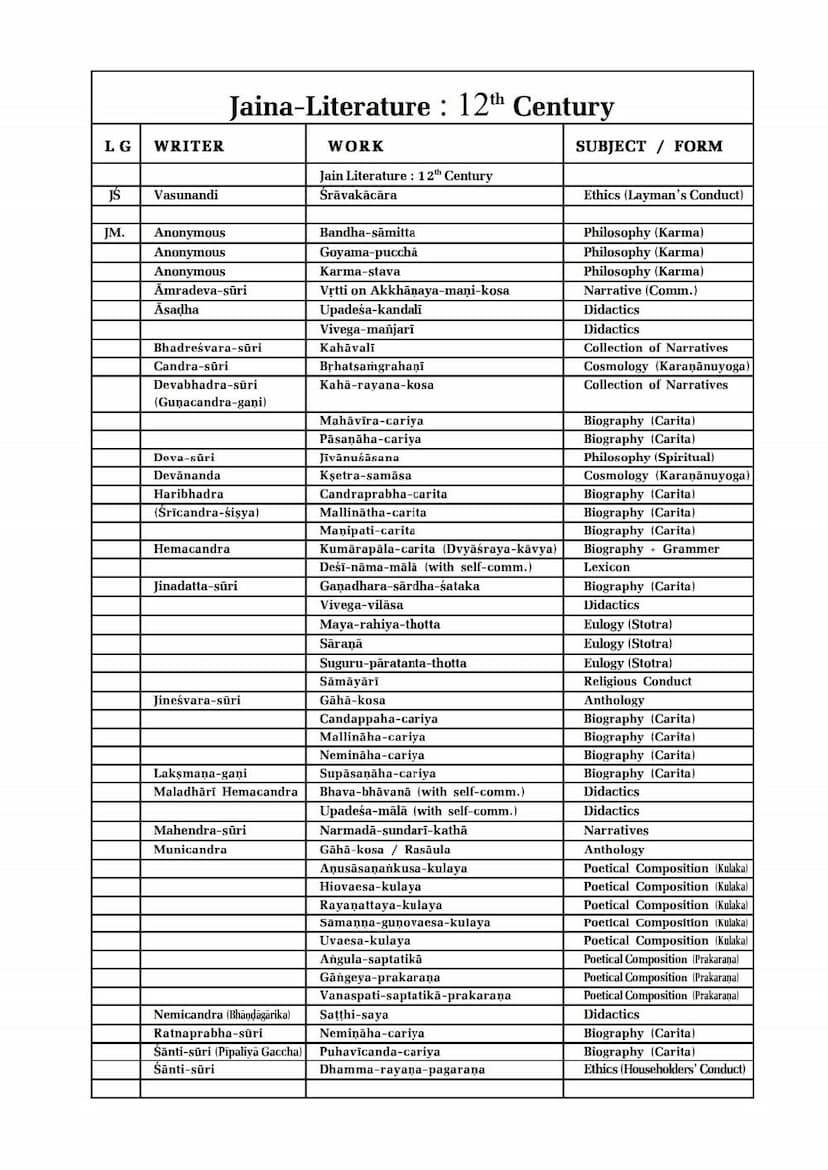Brief Survey Of Jaina Prakrit And Sanskrit Literature Part 3
Added to library: September 1, 2025
Loading image...

Summary
This document provides a comprehensive survey of Jaina literature, cataloging works and authors from the 12th to the 15th centuries. The focus is on the linguistic classification of these works, primarily into Jaina Prakrit (JM.), Sanskrit (Skt.), Jaina Saurasenī (JŚ.), and Apabhramśa (Apa.).
Here's a summary of the findings for each century:
12th Century:
- Peak Period: This century is considered the zenith of Prakrit and Sanskrit Jaina literature, characterized by numerous literary giants.
- Linguistic Distribution: Sanskrit works are most abundant, followed by Jaina Mahārāștrī. Jaina Saurasenī has one work, and Apabhramśa works are fewer, often focusing on biography and didactic themes.
- Key Figures and Works:
- Hemacandra: A prolific genius, known as "Kalikālasarvajña," excelled in JM., Sanskrit, and Apabhramśa. His grammatical works, lexicons, biographies, and philosophical treatises are highly significant.
- Malayagiri: A prominent Śvetāmbara commentator who completed commentaries on a vast range of canonical texts, covering philosophy, karma, ethics, cosmology, and grammar.
- Rāmacandrasūri: A disciple of Hemacandra, who specialized in dramatics, producing secular dramas and contributing significantly to Sanskrit dramaturgy.
- Other Noteworthy Works: Srāvakācāras (ethics for laypeople), Karma philosophy, cosmological texts, and extensive biographical literature (Caritas) dedicated to Tirthankaras and other personalities. Ugrāditya's Kalyāņakāraka on Ayurveda is also highlighted.
- Context: Royal patronage in Gujarat and Rajasthan contributed to the flourishing literary activities. Digambara writers were less active due to Śaivaite movements in South India.
13th Century:
- Continued Activity: Jaina literature continued to thrive, with a significant output in both JM. and Sanskrit.
- Linguistic Distribution: Jaina Saurasenī has one work on monastic conduct. JM. works are numerous, mainly comprising Caritas, narratives, and Prakaraņas. Sanskrit literature is vast and diverse, spanning numerous subjects and forms. Apabhramśa works are primarily biographical.
- Key Figures and Works:
- Amṛtacandra: Known for his commentaries on Kundakunda's works, particularly Puruṣārthasiddhyupāya, which is highly revered among Digambaras.
- Āsādhara: A prolific writer across various genres, including religious conduct (Sāgāradharmāmṛta), legendary history, logic, and philosophy.
- Malliṣeņa and Vādirājasūri: Prominent Jaina logicians whose works, Syādvādamañjarī and Pramāṇanirṇaya, respectively, hold esteemed positions in Indian logic.
- Hastimalla: A Digambara householder and dramatist who produced several dramas with royal support.
- Other Noteworthy Works: Commentaries on classical Sanskrit works, scientific and technical works on animals and birds, and numerous biographical accounts.
- Language Evolution: Apabhramśa literature began showing influences of Old Gujarati and Rajasthani.
14th Century:
- Continuity and New Trends: The linguistic distribution remained similar to the 13th century.
- Linguistic Distribution: Jaina Saurasenī has a single work. JM. works are reasonably good, Sanskrit works are ample, and Apabhramśa works are mostly Sandhis, Rāsas, and Fāgas.
- Key Figures and Works:
- Jinaprabhasūri: An influential Ācārya of Kharatar Gaccha, known for his close ties with Muhammad Taghlaq, his establishment of new rites, and his extensive travelogue Vividhatīrthakalpa. He mastered JM., Sanskrit, and Apabhramśa.
- Prabandha Literature: This century is notable for its "legendary histories" (Prabandhas) by authors like Rājasekhara, Merutunga, Prabhācandra, and Kakkasūri.
- Jayavallabha: Author of Vajjālagga, a unique anthology of Prakrit Subhāṣitas, with a commentary by Ratnadeva.
- Nayacandra: Writer of the Sattaka Rambhāmañjarī and the epic Hammīramahākāvya.
- Thakkura Pheru: A Śvetāmbara householder and treasurer, notable for his JM. works on technical subjects like metallurgy, numismatics, mathematics, and astrology, making his contribution unique.
- Music: Saṁgītasāmayasāra and Saṁgītopaniṣat are highlighted as likely the only Jaina works dedicated to music.
- Focus: Śvetāmbara writers were more active. The "Prabandha form" was popular. Technical works in JM. were significant, but original works in logic were few. The focus leaned towards poetics, grammar, dramas, and didactic narratives, with fewer philosophical works.
15th Century:
- Continued Diversification: Jaina literature continued to be produced in all major linguistic categories.
- Linguistic Distribution: Jaina Saurasenī has one philosophical work (Siddhāntasāra). JM. works are fewer than in the 14th century, primarily Caritas and didactic narrative collections. Sanskrit literature shows maximum activity, with remarkable variety. Apabhramśa works are mostly biographical and narrative.
- Key Figures and Works:
- Caritas: Continued tradition of writing Caritas in all languages, dedicated to Tirthankaras, historical figures, kings, and householders.
- Prabandhas: Legendary histories continued to be written on figures like Pṛthvīdhara, Pethada, Bhoja, and Kumārapāla.
- Kşemankargami: Credited with transforming the anonymous 14th-century Sanskrit work Siṁhāsanadvātrimśikā into prose.
- Samyaktvakaumudi: Three collections of didactic narratives with this title by different authors are noted as peculiar.
- Sakalakīrti: A prolific author of Caritas and Purāņas.
- Mandana: A poet who included his name in his work titles and was skilled in grammar and poetics.
- Cāritravardhanagani: Notable for his anthology Sūktimuktāvali and commentaries on classical Sanskrit epics.
- Satirical Works: The tradition of satire continued with Dharmaparīkņā (Skt.) and Dhammaparikkhā (Apa.).
- Trends: The contribution to logic was meager. Sanskrit didactic works were numerous. Works on Śrāvakācara were few. The century saw a focus on Kathanuyoga (narrative literature) and an attraction towards non-Jaina classical Sanskrit literature, resulting in imitative and commentarial works.
In essence, the document meticulously tracks the evolution and breadth of Jaina literary output across these centuries, highlighting the key authors, their seminal works, and the prevailing linguistic and thematic trends within the Jaina tradition.